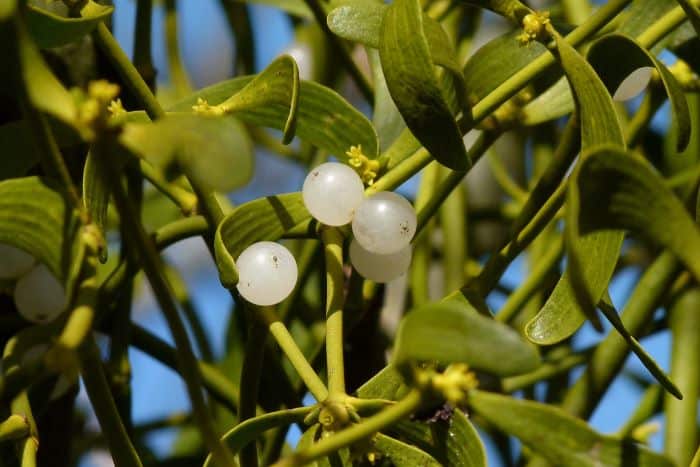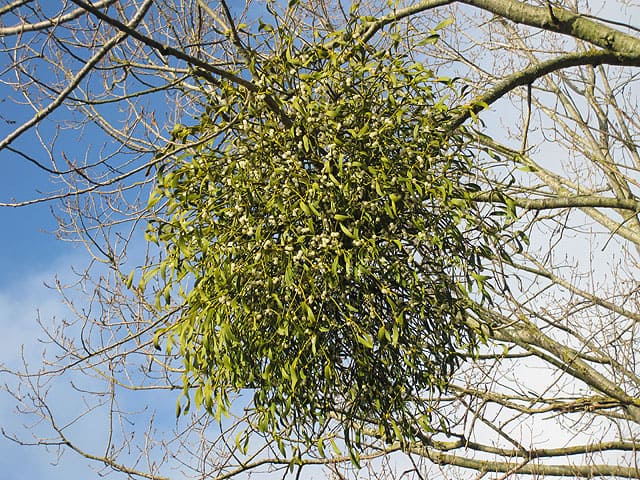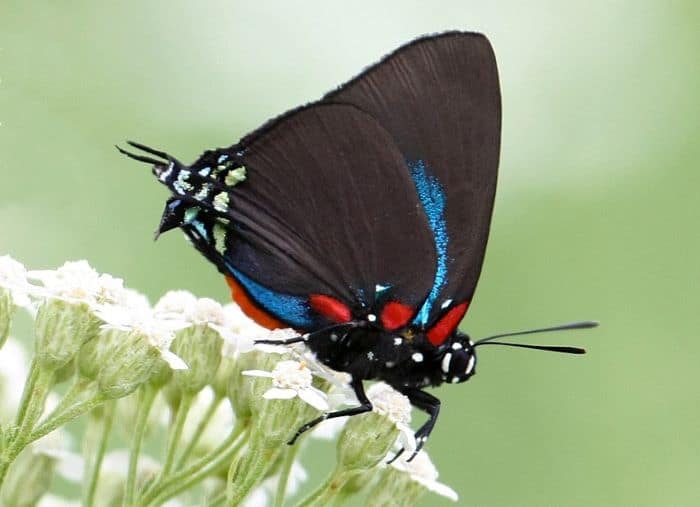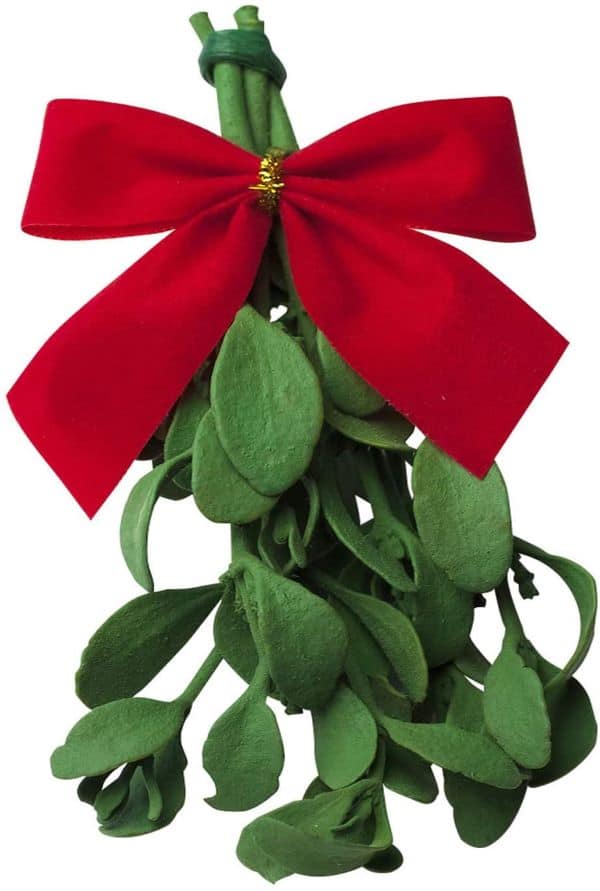
Why do we kiss under mistletoe at Christmas? What are the Christmas mistletoe plant facts?
The tradition of kissing under the mistletoe started way back in 16th century England. The custom traveled to early America, where kissing under the mistletoe was mentioned in a Washington Irving short story, “The Sketchbook of Geoffrey Crayon, Gent.”
In Irving’s day, whenever a couple kissed under a mistletoe sprig, they took off one of the white berries. When all of the berries were gone from the sprig, the kissing power stopped.
How’s that for good luck?
Mistletoe Once Symbolized Romance, Fertility, and Vitality
At Christmastime, we think of kissing under a sprig of mistletoe. In the 21st century, that mistletoe sprig might be artificial. Yet, most folks (like me!) prefer the real thing and order fresh or dried mistletoe to carry on the “kiss under the mistletoe” tradition.
Some scholars believe that the ancient Greeks started the kissing tradition when they celebrated Kronia. The Kronia celebration was in the winter, and the Greeks celebrated the holiday using mistletoe. Soon, couples started kissing under it.
Fast forward to the Celtic druids, who valued mistletoe for its medicinal properties. The druids were probably the first people to use mistletoe to decorate inside their homes.
The Anglo-Saxons named mistletoe: Mistle means dung, and tan (later translated to toe) means twig. So, mistletoe translates to dung-on-a-tree. (Not a very sexy name, is it?)
Where Can You Get Mistletoe?
In today’s world, if you live in California,
Oregon, or other Western states,
you can probably buy real mistletoe
at your local retailers, such as
Lowe’s, Home Depot, and a
Walmart Garden Center.
You can also buy fresh or dried
mistletoe on Amazon.
Your local florist or Christmas tree farm may also carry mistletoe. But only a humbug
uses plastic mistletoe, except in an emergency.!
Kiss Under Mistletoe: But What Is Mistletoe?
Mistletoe is more than a “Kiss Under Mistletoe” good luck charm for young couples. Indeed, mistletoe is a valuable part of our forests’ ecosystem, ranging from Canada to South America.
There are mistletoe species in the desert as well as the dense woodlands of Pennsylvania and northward.
Animals, birds, and butterflies rely on mistletoe for food and nesting. And Texas farmers use mistletoe as forage for their cattle when grass and other grazing materials aren’t available.
That’s not all. European doctors use mistletoe extract to treat colon cancer, one of the most significant causes of cancer in Europe and the U.S. And researchers have found that mistletoe extract is more effective in treating cancer because it’s less toxic than chemotherapy.

Mistletoe is Poisonous to Humans and Pets
If you do snag some real mistletoe for Christmas, be careful with the plant. All of the mistletoe, including its berries, is poisonous to you, your children, and your pets.
You can use mistletoe for Christmas decorations, but make sure it’s in a safe place away from curious kids, dogs, and cats.
You can grow mistletoe, but you need a host tree to grow it on, and it’s labor-intensive. Plus, you would need to buy mistletoe seeds. These seeds aren’t readily available unless you know a Christmas tree farmer that also grows mistletoe.
Kiss Under Mistletoe: Mistletoe’s Ecological Importance
Our heavily wooded forests need mistletoe to help birds, bees, and butterflies to survive and thrive. Fortunately, there are 1,300 leafy mistletoe species throughout the world.
According to the U.S. Geological Survey (USGS) two species of mistletoe grow in North and South America: American mistletoe and dwarf mistletoe.
- Leafy American mistletoe is associated with the kissing custom.
- Leafless dwarf mistletoe is much smaller. It grows from New Jersey to Florida and west through Texas. You can also find dwarf mistletoe in southeast Alaska, Central Canada, the western U.S. and Mexico.
The USGS states that mistletoe has been in the U.S. for 20,000 years. Researchers found packrat middens’ fossilized nests in dwarf mistletoe that date back more than 20,000 years.
And the USGS says that mistletoe has been a natural part of healthy forest ecosystems for thousands to millions of years!
Kiss Under Mistletoe, Even Though It’s a Parasite
Mistletoe is known as a “tree thief” because the plant is “hemi-parasitic.” A hemi-parasitic plant takes some of its nutrients from the host tree, but it also uses photosynthesis to provide additional food for itself.
Mistletoe’s parasitic abilities include sending out branches onto their host tree and taking the tree’s minerals, nutrients, and moisture. Eventually, mistletoe will branch out into a hairy ball that’s called a “witches’ broom.” The Navajo have a kinder phrase for mature mistletoe, calling it “basket on high.”

American mistletoe’s scientific name, Phoradendron, means “thief of the tree” in Greek.
You can see how much this thief wants to propagate when it hitches a ride to a new host plant: It takes only one sticky mistletoe seed to find a new home because it rides on fur, bird beaks, or even a feather that lands on a host tree.
And dwarf mistletoe seeds travel by air. When dwarf mistletoe berries ripen, they blast the seeds into the air to find a host tree. Dwarf mistletoe seeds can travel up to 50 ft. to land on a new host plant.
Also, dwarf mistletoe prefers conifers over deciduous trees in the forest. In desert climates, dwarf mistletoe hitches onto legume trees.
Kiss Under Mistletoe: Birds Need Mistletoe for Food and Shelter
While a “witches’ broom” of mistletoe looks like a mangled mess, it makes a great nesting site for many birds.
The Phalnopeplas, a flycatcher bird that lives in the southwestern and western U.S., dines solely on mistletoe seeds during the winter. And in turn, the phalnopeplas drop the seeds on trees to continue mistletoe propagation. Both the birds and the mistletoe have a mutually beneficial relationship.
Mistletoe also makes excellent feeding sites for other birds that feast on mistletoe berries. These include:
- Bluebirds
- Evening grosbeaks
- Grouse
- Mourning doves
- Pigeons
- Robins
A “witches’ broom” of mistletoe leaves, branches, and berries makes a great nesting site. Birds such as, northern owls, Mexican spotted owls, and other raptors love to nest in this thicket high up in trees.
One U.S.G.S study found the following about raptors and their nesting habits:
- 43% of spotted owls nest in witches’ brooms
- 64% of Cooper hawks nest in overgrown mistletoe in northern Oregon
- Other raptors that live in mistletoe or witches’ brooms include the great gray owl, long-eared owls, goshawks, and sharp-shinned hawks.

Migratory birds in the western United States also like to make their homes in mistletoe and witches’ brooms because they provide a haven from predators. Here’s a list of migratory birds that call mistletoe home:
- Cassin’s finches
- Chickadees
- Chipping sparrows
- Gray jays
- Hermit thrushes
- House wrens
- Mourning doves
- Northern Beardless-Tyrannulet
- Pine siskins
- Pygmy nuthatches
- Red crossbills
- Western tanagers
Want to attract more birds to your backyard? Make Homemade Birdseed Ornaments. It’s easy!
Butterflies and Bees Rely on Mistletoe (But Not for Kissing Under)
Three types of butterflies count on mistletoe to provide food, shelter, and an egg-laying habitat. The hairstreak butterflies drink the mistletoe flowers’ nectar.
Here’s a breakdown of the hairstreak butterflies and their relationship with mistletoe:

- The Great Purple Hairstreak depends on American mistletoe for all of its needs. Great Purple Hairstreaks drink American mistletoe’s nectar and lay its eggs on the plant. When the eggs hatch, the caterpillars feed on the mistletoe.
- Thicket Hairstreak prefers the dwarf mistletoes. The caterpillars eat and live on mistletoe plants.
- Johnson’s Hairstreak caterpillars feed on dwarf mistletoe. The mottled green and olive shades of these caterpillars even mimic the coloration of the mistletoe hosts.
Finally, bees also rely on mistletoe because its flowers serve as the first pollen source in the spring. Bees feed on mistletoe flowers, nectar, and pollen.

Kiss Under Mistletoe
As you can see, mistletoe is part of our winter holiday celebrations and décor. We can thank the early Greeks and Celtic druids for starting those traditions.
Likewise, mistletoe plays a vital role in our natural world, starting with bees and butterflies and moving onto birds. And we, as humans, rely on mistletoe extract to heal our cancers.
So, it’s easy to see that mistletoe is more than a sprig for kissing. It’s a valuable part of our world.
But if someone wants to kiss you under the mistletoe, it’s OK to say yes!
Did you know Amazon had an outlet store?
Check out what’s on sale
at the Amazon Outlet!
Home Garden and Homestead receives a small commission (at no cost to you) for qualified sales generated by links on our website. Thanks for your support!





Leave a Reply